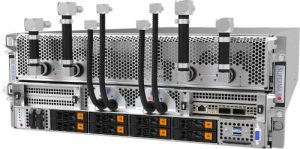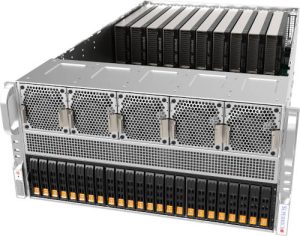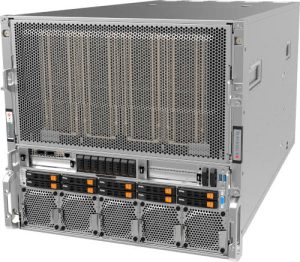“The new systems feature significant upgrades across the board, supporting a never-before-seen 256 P-cores [performance cores] in a single node, memory support up for MRDIMMs at 8,800Mtransfer/s and compatibility with next-generation SXM, OAM, and PCIe GPUs,” according to the company. “These new X14 systems include 10U and multi-node form-factors to enable support for next-generation GPUs, and higher CPU densities, and updated memory slot configurations with 12 memory channels per CPU.”
Among more than 10 variants will be GPU-optimised units, designed for large-scale AI training, large language models, generative AI and high-performance computing (HPC), with eight of the latest-generation SXM5 and SXM6 GPUs, in air-cooled or liquid-cooled configurations.
 For maximum GPU flexibility, PCIe GPU types will hold up to 10 double-width PCIe 5.0 accelerator cards in a 5U chassis. “These servers are ideal for media, collaborative design, simulation, cloud gaming, and virtualisation workloads,” said Supermicro.
For maximum GPU flexibility, PCIe GPU types will hold up to 10 double-width PCIe 5.0 accelerator cards in a 5U chassis. “These servers are ideal for media, collaborative design, simulation, cloud gaming, and virtualisation workloads,” said Supermicro.
Gaudi 3 AI accelerators are in the pipeline: “Supermicro plans to deliver the industry’s first AI server based on the Intel Gaudi 3 accelerator hosted by Xeon 6 processors,” said Supermicro.
Eight Gaudi 3 accelerators will be available on an OAM (open accelerator module) universal baseboard, with six integrated OSFP ports, and “an open platform designed to use a community-based, open-source software stack, requiring no software licensing costs”, said the company.
A 6U X14 ‘SuperBlade’ format has been designed to get 100 servers and 200 GPUs into a rack for AI and HPC – with air cooling or direct-to-chip liquid cooling, and its X14 ‘FlexTwin’ format is intended to squeeze 24,576 performance cores in to a 48U rack – this time with direct-to-chip liquid cooling only.
 At least some of the servers will be compatible with Intel’s impending Xeon 6900 processors with P-cores, its most powerful Xeons ever, and will “offer socket compatibility to support Intel Xeon 6900 series processors with E-cores in Q1 2025”, the company said.
At least some of the servers will be compatible with Intel’s impending Xeon 6900 processors with P-cores, its most powerful Xeons ever, and will “offer socket compatibility to support Intel Xeon 6900 series processors with E-cores in Q1 2025”, the company said.
Xeon 6900 P-cores have Intel’s AMX (advanced matrix extensions) for running AI models, including those trained with FP16 maths.

